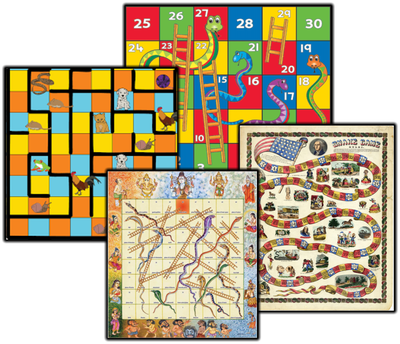Race Game: Difference between revisions
From DT Online
(Created Article) |
mNo edit summary |
||
| Line 17: | Line 17: | ||
* Sketch ideas on plain paper or use '''[[Paper_and_Card|Squared Paper]]''' for example, for guidance. | * Sketch ideas on plain paper or use '''[[Paper_and_Card|Squared Paper]]''' for example, for guidance. | ||
* Draw out a final design accurately on two side-by-side '''[[Paper_and_Card|A4]]''' sheets and enhance ''(e.g. using '''[[Pens and Pencils|Felt Tip Pens]]''' or '''[[Pens and Pencils|Coloured Pencils]]''')'', use '''[[Decoupage]]''' techniques, or use '''[[Using Images|Computer Software]]''' and print out ''(<span style="color: green">'''Note:''' most printers are able to 'Tile' A3 designs by printing out on to two A4 sheets - alternatively the design may have to be organised as two sheets on screen</span>).'' | * Draw out a final design accurately on two side-by-side '''[[Paper_and_Card|A4]]''' sheets and enhance ''(e.g. using '''[[Pens and Pencils|Felt Tip Pens]]''' or '''[[Pens and Pencils|Coloured Pencils]]''')'', use '''[[Decoupage]]''' techniques, or use '''[[Using Images|Computer Software]]''' and print out ''(<span style="color: green">'''Note:''' most printers are able to 'Tile' A3 designs by printing out on to two A4 sheets - alternatively the design may have to be organised as two sheets on screen</span>).'' | ||
* Each half of the finished design can then be pasted on to '''[[Paper_and_Card|A4]]''' pieces of '''[[Paper_and_Card|Thick Card]]''' and either '''[[Laminated]]''', covered with self-adhesive book-covering film or varnished for example. | * Each half of the finished design can then be pasted on to '''[[Paper_and_Card|A4]]''' pieces of '''[[Paper_and_Card|Thick Card]]''' and either '''[[Laminating|Laminated]]''', covered with self-adhesive book-covering film or varnished for example. | ||
* Temporarily secure the two '''[[Paper_and_Card|A4]]''' sheets side-by-side ''(e.g. with weights)'', leave a gap between them equal to the card thickness, and apply '''[[Adhesive Tapes|Adhesive Tape]]''' along the join to form a folding hinge ''(<span style="color: green">'''Note:''' you may have to allow for the tape width down the centre of the opened out board in your design</span>)''. | * Temporarily secure the two '''[[Paper_and_Card|A4]]''' sheets side-by-side ''(e.g. with weights)'', leave a gap between them equal to the card thickness, and apply '''[[Adhesive Tapes|Adhesive Tape]]''' along the join to form a folding hinge ''(<span style="color: green">'''Note:''' you may have to allow for the tape width down the centre of the opened out board in your design</span>)''. | ||
Latest revision as of 08:15, 14 September 2017
What to Make:
(Designers might call this the Design Brief and/or the Specification)
Design and make simple table top Race Game which each player has one piece or counter and takes it in turn to throw a Dice or spin a Teetotum with the aim of being the first to finish a route, track or circuit.
Making the Game Board:
- Design your game to be A3 size (or 2 x A4 size side by side).
- Sketch ideas on plain paper or use Squared Paper for example, for guidance.
- Draw out a final design accurately on two side-by-side A4 sheets and enhance (e.g. using Felt Tip Pens or Coloured Pencils), use Decoupage techniques, or use Computer Software and print out (Note: most printers are able to 'Tile' A3 designs by printing out on to two A4 sheets - alternatively the design may have to be organised as two sheets on screen).
- Each half of the finished design can then be pasted on to A4 pieces of Thick Card and either Laminated, covered with self-adhesive book-covering film or varnished for example.
- Temporarily secure the two A4 sheets side-by-side (e.g. with weights), leave a gap between them equal to the card thickness, and apply Adhesive Tape along the join to form a folding hinge (Note: you may have to allow for the tape width down the centre of the opened out board in your design).
Things to think about:
- What route or track will be followed as the counters move around the board? (e.g. zig-zag, squiggle, spiral, random).
- Will it have a beginning and end or should it be a continuous circuit?
- Alternatively, base the game on a local route or track near where you live (e.g. local footpaths, a tour of sites of interest, a heritage railway line or canal).
- Is the aim of the game just to win the race or is it also to learn something about the places visited on the board?
- Will the game Include forfeits (e.g. move backwards if you land on private land, cows are loose in a field, traffic lights are on red, roadworks, a level crossing barrier is down or a bridge raised) or include also some bonuses (e.g. find a shortcut, hitch a lift, get right of way). These might be triggered by the square landed on or the need to pick a card, throw a second Dice or spin a Teetotum.
- What kinds of playing pieces are envisaged?
- Will a player's score be determined by the roll of a Dice or spin of a Teetotum?
Testing and Evaluation
- Try playing the game with friends (it is a good idea to do this at the first paper-based draft stage to spot problems before committing to a final design):
- is it enjoyable to play?
- does it last too long or about the right amount of time?
- is it possible to cheat?
- would your friends wish to play it again?
- are there any improvements you can make?
Further Work
- Consider how the finished game board, plus playing pieces, can be stored (e.g. a simple Storage Box can be made using Stripwood Technology techniques but more sophisticated options for Box Construction are also possible).
- See how a Folding Game Board can be stiffened with strips of timber if required.











